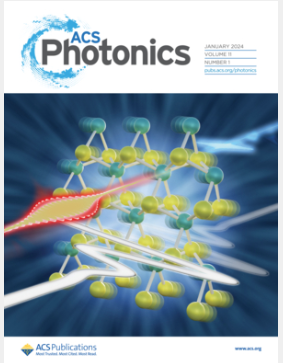用于弱RGB光感知的仿生局部自适应三元CdSxSe1-x记忆光电晶体管
IF 6.5
1区 物理与天体物理
Q1 MATERIALS SCIENCE, MULTIDISCIPLINARY
引用次数: 0
摘要
仿生局部自适应光电晶体管的灵感来自于人类视网膜的视杆细胞,在提高视觉系统在各种应用中的效率方面表现出显著的潜力,包括安全监控、医学成像和精密激光加工。然而,与它们的生物对应物类似,这些设备面临着一个关键的限制:它们的局部自适应光响应难以全面覆盖可见光谱,阻碍了弱照明下的颜色区分。在这项研究中,我们提出了一种基于三元CdSxSe1-x纳米带的仿生记忆光电晶体管(MPT),它将视杆细胞的暗敏性与视锥细胞的色敏性结合起来,实现了在弱光条件下的RGB色彩识别。在富硒气氛中合成的CdSxSe1-x纳米带显示出更少的碳空位和逐渐减小的光电存储窗口,证实了这些空位作为表面氧吸附位点形成存储介质的关键作用。利用电荷存储积累效应和能带工程,我们实现了300-725 nm宽可见范围内的弱光检测,比探测率超过1017琼斯。通过CdS0.30Se0.70、CdS0.58Se0.42和定制光谱特性的CdS mpt协同工作,实现了200 nW·cm-2波段弱RGB光在光谱自适应模式下的检测和识别。这种杆状启发的暗色调适应与锥状色觉的融合为下一代视觉感知技术的发展提供了一种创新的设计理念。本文章由计算机程序翻译,如有差异,请以英文原文为准。

Bionic Scotopic-Adaptive Ternary CdSxSe1–x Memory Phototransistor for Weak RGB Light Perception
Bionic scotopic-adaptive phototransistors, inspired by the rod cells of the human retina, exhibit remarkable potential for enhancing the efficiency of vision systems in diverse applications, including security surveillance, medical imaging, and precision laser machining. Nonetheless, similar to their biological counterparts, these devices face a critical limitation: their scotopic-adaptive photoresponse struggles to comprehensively encompass the visible spectrum, impeding color differentiation under weak illumination. In this study, we present a bionic memory phototransistor (MPT) based on ternary CdSxSe1–x nanoribbons, which integrate the scotopic sensitivity of rods with the chromatic acuity of cones to enable RGB color discernment in weak-light conditions. The CdSxSe1–x nanoribbons synthesized in a selenium-rich atmosphere exhibit fewer chalcogen vacancies and a progressively reduced photoelectric storage window, confirming the pivotal role of these vacancies as surface oxygen adsorption sites forming a storage medium. By leveraging the charge storage accumulation effect and energy band engineering, we achieve weak light detection across the broad visible range of 300–725 nm, with a specific detectivity surpassing 1017 Jones. Through the synergistic operation of CdS0.30Se0.70, CdS0.58Se0.42, and CdS MPTs with tailored spectral properties, we accomplish detection and discrimination of weak RGB light at 200 nW·cm–2 under scotopic-adaptive modes. This integration of rod-inspired scotopic adaptation with cone-like chromatic discrimination offers an innovative design concept for the development of next-generation visual perception technologies.
求助全文
通过发布文献求助,成功后即可免费获取论文全文。
去求助
来源期刊

ACS Photonics
NANOSCIENCE & NANOTECHNOLOGY-MATERIALS SCIENCE, MULTIDISCIPLINARY
CiteScore
11.90
自引率
5.70%
发文量
438
审稿时长
2.3 months
期刊介绍:
Published as soon as accepted and summarized in monthly issues, ACS Photonics will publish Research Articles, Letters, Perspectives, and Reviews, to encompass the full scope of published research in this field.
 求助内容:
求助内容: 应助结果提醒方式:
应助结果提醒方式:


